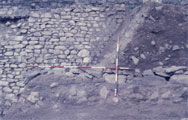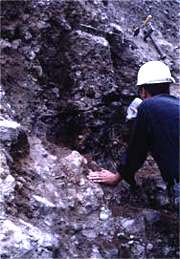 |
 |
|
|
|
|
|
|
|
|
|
|
|
|
|
|
|
|
|
|
|
||||||||||
|
|
|
|
|||||||||
|
|
|||||||||||
|
|
|
||||||||||
|
|
|||||||||||
|
|
|
||||||||||
|
|
|||||||||||
|
|
|
||||||||||
|
|
|||||||||||
|
|
|
||||||||||
|
|
|||||||||||
|
|
|
||||||||||
|
|
|||||||||||
|
|
|
||||||||||
|
|
|||||||||||
|
|
|
||||||||||
|
|
|||||||||||
|
|
|
||||||||||
|
|
|||||||||||

Louisbourg has a rich archaeological record: it has the largest collection in the world of artifacts related to an 18th-century town. As a center of commercial trade, Louisbourg afforded its inhabitants access to a wide array of consumer goods from around the world. For archaeologists, this history has meant a wealth of material and research opportunity.
The Louisbourg archaeological collection consists of two components: 1) the artifacts recovered during the course of 35 years of an archaeological program at the site, and 2) the records, reports and notes generated by excavation, analysis and collections or resource management.
Comprised of approximately five million items, the archaeological collection includes a wide variety of materials that require diverse storage and conservation techniques. The majority of the artifacts date between 1700 and 1768, except for a few which were deposited after the departure of the British garrison. The latter serve as time markers for various archaeological contexts or deposits, but consist of less than two percent of the collection.
History of buildings surrounding the fortress
The role of archaeology
Louisbourg is a unique archaeological resource. The 18th-century town was a fast-growing urban area. In contrast to most other urban centers, its defeat in the third quarter of the 18th century and the subsequent sparse settlement allowed the archaeological record at Louisbourg to, in effect, stand still in time. Although portions of 17th and 18th-century Quebec or New York exist, most urban centers have been built over or are riddled with sewage, utility or subway lines. Louisbourg has survived relatively intact. The small-scale 19th and 20th-century settlements that followed the earlier more dense occupations did little to disturb the original, and its remote location helped to preserve it from looters or wholesale salvaging for building materials.
The extensive sites left by the British military during the sieges of Louisbourg have yet to be excavated.
Granted, many collections of individual types of artifacts, or collections with holdings from a number of single sites or parts of sites already exist elsewhere. However, in North America at least, the Louisbourg collection of artifacts -- from over 50 separate but related properties, most of them completely excavated -- is a unique resource for many reasons. It is the only collection with sufficient quantities of contextual units to permit statistically valid analyses. It is the only collection from a major urban settlement that was left essentially as a time capsule from the late 18th century until today.

| Looking in Kennelly's Drain (Kings Bastion). |

| Preparing Monauth behind Right Face of King's Bastion. |
|
|
||
 |
Visitor Activities | Educational Interests | Team Hermosa | Feedback | Home |
|
|
|
||


without the permission of the Fortress of Louisbourg National Historic Site. In all cases, please
credit the author, Parks Canada, and the organization.